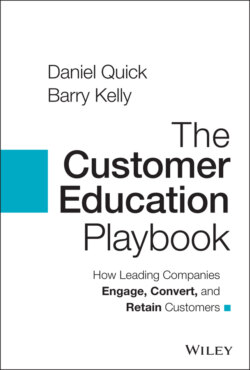Читать книгу The Customer Education Playbook - Daniel Quick - Страница 6
Introduction
ОглавлениеIn today's subscription economy, your business is unlikely to survive if your customers aren't gaining value from your products. This is a sound argument for developing great products, of course, but that's not enough. After all, how can customers gain value from something they don't know how to effectively use? For your customers to achieve their desired outcomes, you must teach them what they need to know. Enter customer education, a rapidly evolving field that focuses on teaching customers the right things, at the right time, so that they find value from your products and become advocates of your brand. An educated customer is a satisfied customer that delivers long-term value to your business.
Here's a secret. Customers are always learning, and they are learning at every stage of their lifecycle. Whether they are learning how to solve their problem, why your solution is better than others, or how to develop mastery with your product, customers are being educated and educating themselves, for better or for worse. Left to their own devices, customers will often struggle through this learning process; many will fail to adopt your product, much less become masters of it. Without a customer education strategy, learning will happen anyway – just not the kind that positively impacts your business. You don't want customers learning the wrong things; that your product is “difficult to use,” for example, or “doesn't offer value to someone like me.”
Whether you think you are or not, you're probably already investing in customer education. If you're putting money into content marketing, account managers, or customer support – you're educating your customers. The question is, are you educating them successfully? Are you simply reacting to events as they occur, or are you able to plan ahead so that you can proactively empower your customers at each stage and optimize your business for scale?
At Thought Industries, we are seeing more and more companies looking to create a more strategic plan for their customer education. After all, companies who are leaders in their categories, like Salesforce, Gainsight, HubSpot, Motorola, and 3M, all invested early in customer education as a way to maximize and scale lifetime value, and this paints a compelling picture. There is an immense amount of untapped value lying unclaimed on the table.
However, that doesn't mean that developing a customer education strategy is easy. As a new field, practitioners often lack prior experience, and there are very few resources to help them achieve success in their roles. They can't even reliably look for guidance from their managers, who – lacking experience themselves – will usually expect customer education specialists to simply “figure it out.” In this reality, how can new customer education functions (1) form and pitch their strategies; (2) effectively communicate their goals; (3) identify the optimal formats for their content; and (4) distribute, measure, and monetize the training they create?
These early-stage challenges are so great that many organizations find themselves caught in a sort of inertia. According to our 2020 State of the Customer Training Report, 96 percent of companies believe that customer training is important to their organization. The value of training is not in question here. However, almost half stated that they are struggling to measure the impact of training programs, and only 14 percent believe a majority of their customers are adequately trained.
With our finger on the pulse of the industry, and a combined 50 years in the industry, we recognize that educating customers might be essential, but that doesn't make it straightforward, especially as no two customers are the same. They are all learners, but they all need something different. Effective customer education requires an investment. Yes, that means investing in technology for delivering engaging customer learning rather than relying on a traditional, internal-facing learning management system (LMS) that is more suited for employee and corporate training. However, more importantly, we've seen how essential it is to invest in a cohesive, central strategy that pulls all the different elements of a successful program together.
The Customer Education Playbook: How Leading Companies Engage, Convert, and Retain Customers, the bulk of which comprehensively discusses a framework we call the Customer Education Playbook, will help you develop that strategy. In Chapters 1–2, we'll define customer education and discuss how to operationalize it in your business, whether you're just getting started or hoping to mature your program. In Chapters 3–14, we'll cover the 12 steps of the Customer Education Playbook, all of which are based on research conducted from speaking to hundreds of customer education professionals and executives across multiple B2B industries. Finally, in Chapters 15 and 16, we'll explore the phases to achieving a mature customer education function and give you our thoughts on the future of the industry.
Our hope is that the Customer Education Playbook will help professionals on the ground to develop a clear and structured approach that leads to impactful, engaging, and measurable customer education programs. As you read the following chapters, you'll learn the answers to all of those questions you've previously been expected to “figure out on your own,” and you will get practical and actionable advice on how to effectively target and educate your customers – transforming them from prospects to champions.
